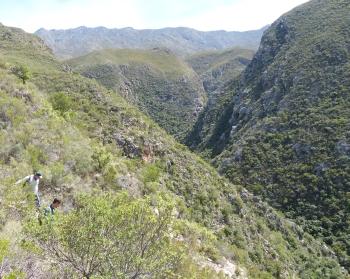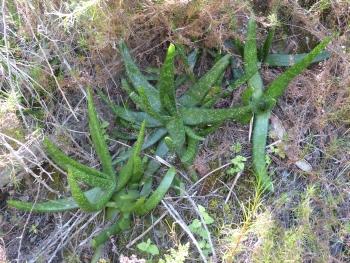Gasteria koenii
Gasteria koenii Van Jaarsv.
Family: Asphodelaceae
Common names: Osberg ox-tongue (Eng.); osberg-beestong (Afr.)
Introduction
Gasteria koenii is an exciting recent discovery, confined to the southern foothills of the Groot Swartberg, near Calitzdorp. The mottled, sickle-shaped leaves are often long, narrow and drawn out and leathery, and grow in a central rosette. The leaves are brittle and those becoming detached, are very prolific, forming plantlets from the base. It is one of the few species of Gasteria flowering in autumn. The raceme is simple, with small, pendent, orange-red to pinkish flowers.

Description
Description
Plants stemless, ascending to about 300 mm tall, 350 mm in diameter. It is prolific from the base, forming clusters with 3–8 heads. The roots are succulent, up to 5 mm in diameter. Leaves in a rosette, drawn out, triangular spear-shaped, 150–300 mm long, 20–45 mm broad at the base, sickle-shaped and curving upwards, sometimes twisted and unevenly parallel; the upper surface flat to shallowly channelled, plane towards the end, faintly to densely white-spotted; lower surface somewhat rounded with a distinct eccentric keel, faintly to densely spotted, the spots arranged in obscure transverse bands; both surfaces shiny, light to dark green, with smooth epidermis; the margin minutely denticulate to almost entire; the leaf tip is acute to acute drawn out bearing a sharp, hard point. Juvenile leaves in opposite and in 2 rows (distichous), tongue-shaped and spreading.

Inflorescence a raceme, up to 700 mm long; the orange-red to pinkish flowers all pointing to the centre of the plant. The inflorescence stalk is about 5–7 mm broad at the base, flattened; the floral bracts 7 × 2 mm, and the flower stalks (pedicels) about 5 mm long, pink. The flowers are 20–21 mm long, swollen at the base (gasteriform) and gently bent, the floral leaves (segments) fused for their greater length and almost cylindrical. The flower base is inflated to about 5–6 mm, pink, upper half white with green striations; apices erect becoming erectly spreading, obtuse; margins of inner segments free and channelled at the base for 7 mm, diverging gradually towards the apex. Stamens 10–12 mm long; anthers 2 × 1 mm long, included. Ovary 5–6 mm long, 2–3 mm in diameter, green; style 7 mm long; stigma included, minute. Capsule narrow obovate, 22–30 mm long, triangular in cross-section, obtuse at apex, 6–8 mm diam. Seeds blackish.
Flowering time is in autumn.
Conservation Status
Status
Although the plant has a restricted distribution and is only known from a single kloof, it has not yet been assessed for the Red List of South African plants (Raimondo et al. 2009). It is best categorized as Rare. The population of G. koenii seems to be thriving in spite of local predation by bushpig and porcupine.

Distribution and habitat
Distribution description
Gasteria koenii is only known from Smitsrivier Gorge, the southern foothills of Osberg, which is part of the Groot Swartberg Mountains, in the Klein Karoo region of the Western Cape. It grows on humus-rich slopes, among moss, in mineral-poor, acidic, quartzitic sandstone rocks. The vegetation consists of dry Fynbos and it often grows in partial shade. It is pollinated by local sunbirds. The climate in the region is mild. Rainfall can occur at any time of the year and ranges from 600–800 mm per annum, with a peak in autumn and spring. The average maximum temperature is about 24–25°C and the average minimum about 8°C. Summers can become very hot during windless days. Winters are mild and frost in the habitat is absent.
The vegetation in its habitat consists of Montagu Shale Renosterveld (FRS7) and Northern Swartberg Sandstone Fynbos (FFs23), which is part of the Fynbos Biome (Mucina & Rutherford 2006). Plants grow on steep, south-facing slopes and cliffs in soil derived from quarzitic sandstone of the Peninsula Formation (Cape Supergroup). It also, but to a lesser extent, grows on shales of the Cango Group (Malmesbury Supergroup). Associated trees and shrubs in its habitat include Brachylaena neriifolia, Buddleja saligna, Carissa bispinosa, Cassine peragua, Dodonaea viscosa var. angustifolia and Noltea africana. Associated succulents growing in its habitat include, Adromischus triflorus, Bulbine favosa, Crassula cultrata, C. orbicularis, C. perforata and C. rupestris, Curio ficoides and C. muirii, Dioscorea hemicrypta, Haworthia herbacea (= H. translucens) and Portulacaria afra.
Gasteria koenii belongs to section Gasteria, series Gasteria, which includes 8 species, Gasteria disticha, G. brachyphylla, G. bicolor, G. baylissiana, G. glomerata and G. rawlinsonii (Van Jaarsveld 1994). All these species have smallish flowers (less than 35 mm long) that are gasteriform (swollen like a belly) for a third of the perianth length. From all these species, it is at once distinguished by its long, linear to linear-lanceolate, smooth leaves in a rosette and its inflorescence which is unbranched.

Derivation of name and historical aspects
History
Gasteria koenii is named for Kevin Koen, horticulturist and conservationist from Calitzdorp. The Smitsrivier Gorge where our species has been found, is relatively unknown and demands a few hours hike. To the west (about 7 km) is the Gamka River, a tributary of the Gouritz River and which has cut a deep gorge through the Groot Swartberg. It was found by Kevin during 2010 when he came across a medium-sized species of Gasteria growing in a deep gorge, on steep east-, north- and northwest-facing slopes. In September 2016, accompanied by Kevin Koen, Kelly Griffin, Brian Kemble and Walker Young, an expedition was arranged to investigate this plant, which was found to be distinct.
This species was named in Haseltonia, an American succulent plant journal (Van Jaarsveld 2017) and illustrated by Marieta Visagie.
Except for Gasteria brachyphylla, which is quite common in the Succulent Karoo region near Calitzdorp, and G. vlokii from further east along the Swartberg Mountains, no gasterias have previously been documented from this region, which is mainly because of a lack of adequate infrastructure. However, this gap in distribution has now been filled; G. koenii which is as yet only known from this gorge, is probably more widespread.

Ecology
Ecology
The large, tubular, orange-red to pinkish pendent flowers are produced and pollinated by local sunbirds. After fertilization, the capsules mature and become erect, opening from the end. Strong winds will release seed from the capsules and disperse them.
The passive resistance of Gasteria koenii, an adaptation to herbivore predation, ensures its survival. The leaves of G. koenii are brittle and when becoming detached, will rapidly callus (form healing tissue) and root, forming new plantlets.
Uses
Use
Apart from its horticultural potential, it is not known to be used in other cultural aspects.

Growing Gasteria koenii
Grow
Gasteria koenii is a decorative plant with horticultural appeal and is best grown in containers or in dry fynbos, succulent karoo or meditteranean-type gardens.
It grows best in a slightly acidic, sandy soil mix with ample organic material added. Water sparingly throughout the year. In cold climates where frost is a problem, it should rather be grown in a greenhouse under controlled conditions. Gasteria koenii is a slow grower, but this can be hastened with an organic fertilizer. Grow plants preferably in partial shade. Plants should flower in about 3 years. Plants are self-sterile. Pollinate the flowers by hand, ensuring healthy genetic variability from which selection could be made. Take a sharpened match stick and transfer the pollen from a genetically different plant, ensuring pollination.
Gasteria koenii is easily propagated from seed, or leaf cuttings. Sow seed in winter or spring, in a shady position, in a sandy, slightly acidic soil mixture and keep moist. Cover with a thin layer of sand. Germination is usually within 3 weeks. Seedlings grow slowly and the young plants can be planted out as soon as they are large enough to handle. Apply a fungal inoculant or fungicide when grown from seed. Sow seed preferably in winter, spring or summer. Leaf cuttings can be taken throughout the year. Allow the leaf cutting to form a callus, by placing it on a dry window sill for a week or three. Then root cuttings in a small container in a well-drained medium. Once plantlets appear at the base of the leaf, it can be detached when strong and easy to handle. Feed plants with an organic fertilizer (compost or any other liquid fertilizer).
References
- Mucina, L. & Rutherford, M.C. (eds) 2006. The vegetation of South Africa, Lesotho and Swaziland. Strelitzia 19. South African National Biodiversity Institute, Pretoria.
- Raimondo, D. et al. 2009. Red list of South African plants. Strelitzia 25. SANBI (South African National Biodiversity Institute), Pretoria.
- Van Jaarsveld, E.J. 1994. Gasterias of South Africa. A new revision of a major succulent group. Fernwood Press in association with the National Botanical Institute, Cape Town.
- Van Jaarsveld, E.J. 2017. Gasteria koenii, a new Gasteria species from the Swartberg Mountains, Western Cape, South Africa. Haseltonia 23: 48–52.
Credits
Ernst van Jaarsveld
Kirstenbosch National Botanical Garden (Retired)
Babylonstoren Farm
Extraordinary senior lecturer and researcher, Department of Biodiversity and Conservation, University of the W. Cape
March 2018
Plant Attributes:
Plant Type: Succulent
SA Distribution: Western Cape
Soil type: Sandy
Flowering season: Autumn
PH: Acid
Flower colour: Red, Pink, Orange
Aspect: Full Sun, Shade, Morning Sun (Semi Shade), Afternoon Sun (Semi Shade)
Gardening skill: Easy
Special Features:
Horticultural zones








Rate this article
Article well written and informative
Rate this plant
Is this an interesting plant?
Login to add your Comment
Back to topNot registered yet? Click here to register.